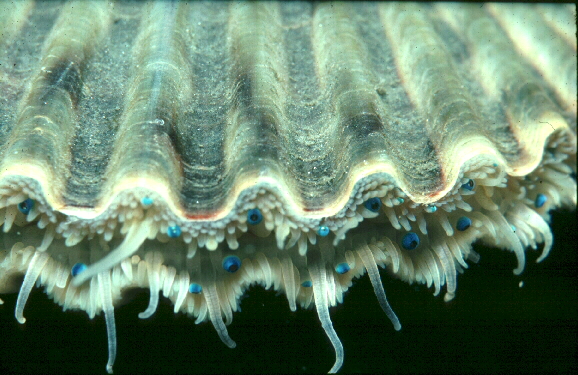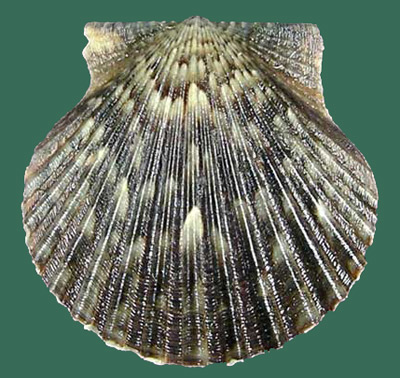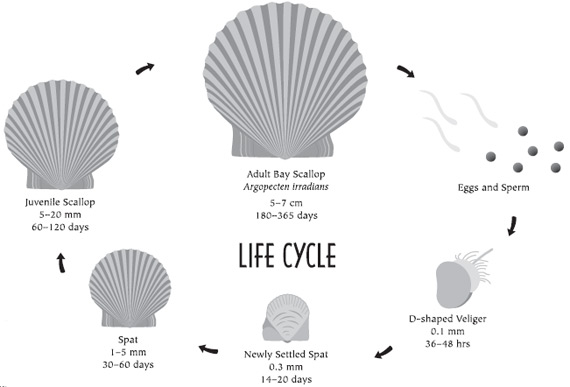Aequipecten irradians
The scallop shells you typically find on the beach are bay scallops. Ocean scallops that occur off the coast of New Jersey produce flatter and larger shells. These are much rarer to find washed up on the beach. The design of the scallop shell has been used in an ornamental fashion for so long and in so many ways that most people are able to recognize a scallop shell when they see one. The edges of the bay scallop shell are fluted and arranged in a fan shape. Colors can vary widely on the outside, from dark to light. Inside the shell is typically smooth and lighter colored, often having a pearl like sheen.
While we find scallop shells singly, they are a bivalve mollusk and have two halves. Their shells are held together by a muscle, which is the "scallop" that seafood lovers enjoy eating. The ocean scallop (Placepten magellinacus) provides the basis for one of the local areas largest commercial seafood products. The bay scallop is good to eat too but is not harvested or sold with anywhere near the volume of the ocean species. The scallop is also used for swimming, which bay scallops do a lot of, and can be seen in this video:
Bay scallops spend their lives in and around seagrass beds. Adults can sometimes be found in open sandy areas, and they can live in such places, but they need the seagrass for their juvenile stages and to hide from predators. You can see scallops in seagrass in the swimming scallops video shown above, although the filming for that was done in Florida and not in Barnegat Bay. Bay scallops live in estuaries along the Atlantic coast and in the Gulf of Mexico (Cape Cod to Laguna Madre, Texas).
Scallops swim by using their largest muscle to clap their shell open and closed. The closing motion forces water out of the unhinged side of the paired shells and propels them forward. The edges of the shells have many blue eyes. These do not form images but are able to detect differences in light intensity. Their swimming is used to find places to hide and also to avoid predators. They eat by filter feeding, moving water over a series of gills that can filter out small microrganisms. Healthy scallop populations can provide a minor but not insignificant amount of water cleaning services by the collective volume of water they filter through their feeding.

Here you can see the beautiful blue eyes of the scallop. They are found on small stalks that can be turned in order to detect the direction of light intensity differences.
Bay scallops are not long lived or large creatures. The average life span is from 18 to 30 months, with most adult shells reaching a mature size that is slightly less than 2 inches.

Learn More About Scallops
Read about juvenile scallop development. This is a link to a scientific paper that describes the early life history and growth of bay scallops from first hatching to an adult.

History of the Bay Scallop, Argopecten irradians, Fisheries and Habitats in Eastern North America, Massachusetts through Northeastern Mexico A scientific paper that describes the history of bay scallop commerce.
Scientific papers about Bay Scallops A listing of all the known papers, through 1987, about Bay Scallops.
This 1965 film clip covers a lot of ground about sea scallop biology. It is amazingly well done for its time both in terms of the information provided and the scenes it shows. The film is not in great shape though so some of the scenes are a bit rough.
Return to the Beachcombing page
Return to the top of the page
